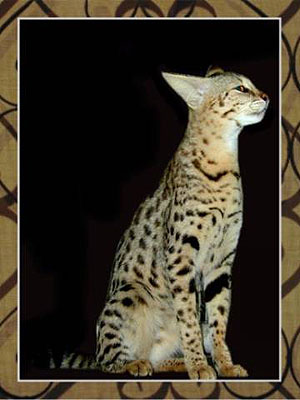 Katie had me. With one paw on firmly on my shoulder and the other on my head, her teeth gently explored my hair. I knew if I pushed away, she would tighten her grip, so I sat still and breathed. She stepped back and examined me with her large, green eyes. I stroked the fur on her soft, HUGE body and felt awe. I was spending time with an almost wild feline, an F1 savannah cat.
Katie had me. With one paw on firmly on my shoulder and the other on my head, her teeth gently explored my hair. I knew if I pushed away, she would tighten her grip, so I sat still and breathed. She stepped back and examined me with her large, green eyes. I stroked the fur on her soft, HUGE body and felt awe. I was spending time with an almost wild feline, an F1 savannah cat.
For months I avoided this visit. Friends of friends bred the cats in their beautiful mission district victorian and I had been invited often, but I was opposed. Why would breed cats when there are hundreds of beautiful cats euthanized each day? And savannahs, the newest designer breed, hybrids of domestic cats and real African servals? As an ethical person and a conservation specialist at The Oakland Zoo, I just could not go.
But eventually, I went and spent 2 magical hours playing with this houseful of savannahs. While Katie was an F1 (a direct offspring of a serval parent and domestic parent) the others were F2s or F3s. Some were striped, some were marbled, some were older and 3 were kittens, yet all of them were ultra curious, athletic, smart and affectionate. They sped around the house, leaping from window sill to fireplace mantel, entertaining each other as well as the rapt house guests. My hosts obviously loved their cats, took incredible care of them and sold them only to exceptional families who promised to keep them indoors. They told me that they made excellent pets, were the feline canine in personality, lived for 17-20 years and were a breed classified as domestic by the USDA, meaning they were legal.
I went home confused and began my own research.
Apparently, our society is obsessed with exotic cats. There are 4000 wild tigers in this world and 8000 pet tigers in the United States. We are breeding cats like crazy, trying to create that wild, exotic look. The savannahs sell for $4000 to $10,000 and are actually illegal in some states and cities. There are savannah cats, bengal cats, ocicats, toygers and pixie-bobs and gosh knows what else. Some do end up as excellent pets, and some end up in shelters or put down after peeing on everything and tearing up sofas.
